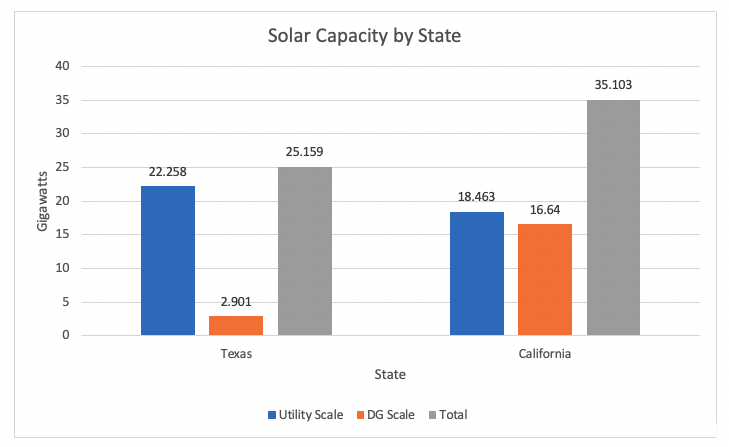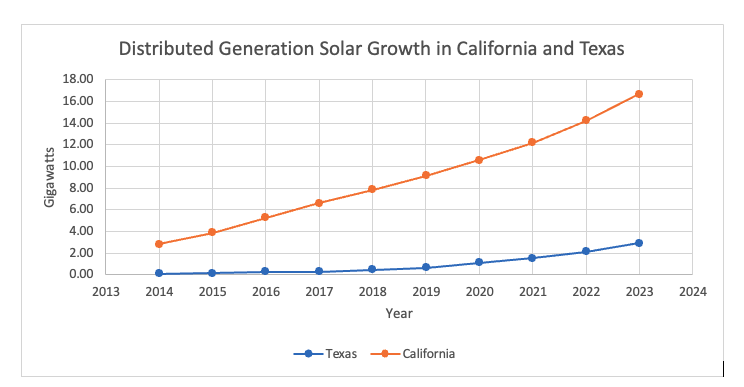Why Texas Leads California in Wind, but Not Solar
By Kamil Cook
Why Texas Leads California in Wind, but Not Solar.
Texans usually don’t take kindly to California one-upping the Lone Star State. But in the race to deploy rooftop solar energy, Texas’ leaders are letting California win — easily.
In October 2023, Texas passed California and now leads all states for the most installed utility-scale solar capacity. While that lead is projected to grow, Texas still lags way behind California in total installed solar capacity by 20,000 megawatts (MW).

Both states have a plentiful supply of sunshine. In fact, California and Texas lead the country with the most solar energy generated and the highest potential for solar generation. That said, a significant difference exists between the economics of a solar farm (utility-scale) and a rooftop solar system (distributed-scale). Utility-scale solar is cheaper because of the economy of scale, but that’s not the only difference. Solar farms can compete and sell energy into the wholesale electricity market, whereas customers with rooftop solar rely on utility rate policy to enable them to receive value for the energy they produce.
What sets the two states apart is policy. California lawmakers have supported both distributed and utility-scale solar for the last 20 years, making the state the leader in solar generation. Texas lawmakers, on the other hand, have prioritized only utility-scale generation, making it the national leader in wind energy and utility-scale solar but a laggard on rooftop solar. In fact, Texas is a decade behind California in rooftop solar.

NEM 2.0 was implemented in July 2017. NEM 3.0 was implemented in April 2023.
Texas is ten years behind California in terms of distributed generation deployment. And it is unlikely that Texas will have the same kind of growth that California has without policies that are more supportive of rooftop solar like a net metering tariff or a comprehensive value of solar rate. The unsupportive regulatory system for rooftop solar has been slowing down its adoption because there are no set statewide rules that mandate how customers are compensated for the electricity they provide to the grid. These islands of rooftop solar policy, separated by utility service area, make it difficult for rooftop solar to take off in Texas.
Policies and Regulations in California
California’s early solar support consisted of government subsidies and solar-friendly policies. The California Public Utilities Commission played a significant role in this through its Net Energy Metering (NEM) tariff, which it introduced in 1996. NEM encouraged distributed-scale solar generation (rooftop solar) by mandating that energy sent to the grid by the solar system be compensated at the same price as energy from the grid.
This solar-supportive policy—one of many—encouraged the rise of rooftop solar. Today, solar power from utility-scale and distributed systems constitutes a significant portion of California’s energy mix, accounting for 27% as of 2022. And 8% of California’s total energy mix comes from distributed solar. With such high solar penetration in the grid, though come issues of frequency regulation. As the sun rises, electric generators can be shut off as most of the demand is met by solar generation. As the sun sets in the afternoon and the amount of electricity people consume increases, other energy sources need to come online quickly to balance the amount of electricity serving the grid with electric demand.
One solution is battery storage, which can store the electricity generated during the day and be sold to the grid when the sun sets. California’s current NEM 3.0 policy (approved at the end of 2022) reduced the compensation customers receive for sending electricity back to the grid by about 75%, to strongly encourage pairing batteries with home solar systems. This new rule has dramatically slowed the pace of rooftop solar installations in California, but growth is expected to continue in the coming years, thanks to federal incentives.
Solar Policies and Regulations in Texas
Unlike California, Texas politicians have not prioritized distributed solar generation. The state’s Republican majority in the Legislature is more likely to attack renewables and shield fossil fuels. However, in the last ten years, as the price of solar panels has declined, the amount of utility-scale solar has jumped. The Texas utility-scale solar industry has boomed because of the low prices for panels, as well as the large amount of cheap land on which to build. In general, economics have driven the proliferation of solar in Texas, rather than policies, which can largely explain why Texas is now leading in utility-scale solar but still falling way behind in distributed generation solar.
Texas’ grid also makes it easier for large amounts of storage to come online. Interconnection times in the Texas grid are the fastest of any regional grid in the country, which could result from the grid manager’s—the Electric Reliability Council of Texas (ERCOT)—unique interconnection process colloquially called ‘connect and manage.’ The utility-scale solar industry in Texas is also growing faster than California’s because the Lone Star State’s grid has not faced the frequency regulation issues that come when solar is a significant part of the energy mix. In 2022, solar only comprised 5% of the ERCOT market’s power. According to the Energy Information Administration, distributed generation solar accounted for less than 1% of the ERCOT market’s electricity generation total (distributed solar made up one-eighth of the 5% of the energy on the grid that comes from solar). Texas’ regulatory regime has prioritized procuring utility-scale generation rather than reducing load through energy efficiency or widespread distributed solar generation, like in California and other states.
Developers, solar companies, and financial institutions are set to make a lot of money in Texas through the growth of utility-scale solar. At the same time, electric utilities are eliminating net metering policies that benefit the average person with a solar installation on the roof of their home or business. As solar farms grow in Texas, residents and small business owners without the economic or political clout of large-scale energy producers are seeing the affordability of rooftop solar slip away. To many lawmakers and regulators in Texas, distributed solar generation is an afterthought, if that.
The Future of Distributed Solar in Texas
What can comparisons between Texas and California’s regulatory and political regimes teach us about our current moment in Texas? One lesson is that statewide action is needed to increase distributed generation solar in Texas.
Because Texas has never had a statewide net metering policy or incentives for solar, the distributed solar industry in Texas has remained much smaller than in California. Texas has fewer solar workers today than California had ten years ago. In 2014, when California rooftop solar capacity was approximately the same as Texas rooftop solar capacity is today, there were over 54,000 solar workers in California. Today in Texas there are 11,250 solar workers. This demonstrates how utility-scale solar creates far fewer jobs than rooftop solar. Companies won’t invest at the same level when the regulatory environment is unsupportive and/or uncertain. In the absence of statewide policy or regulation, Texas utilities have been abandoning net metering and offering unfairly low avoided cost rates for solar energy production.
As this report on Texas rooftop solar, recently released from Public Citizen’s Texas office, argues, statewide policy effort is needed to ensure the continual interconnection of rooftop solar. Without a statewide mandate, perhaps one like California’s original NEM tariff, rooftop solar will only be affordable to the most well-off Texans or to Texans who happen to be in the service area of utilities that have fair policies (which is a minority of utilities in Texas).
Without fair compensation policies, the benefits that rooftop solar can provide to the Texas grid will be hard to realize. Rooftop solar can alleviate transmission constraints that raise electricity prices for everyone; it can decarbonize the grid reducing the amounts of deaths attributable to air pollution each year; it can keep the lights on when our fragile grid’s natural gas supply is interrupted. Without a statewide policy of some kind, it will be incredibly difficult for rooftop solar to take off like it has in California.
Kamil Cook is a climate and clean energy associate for the Texas office of Public Citizen